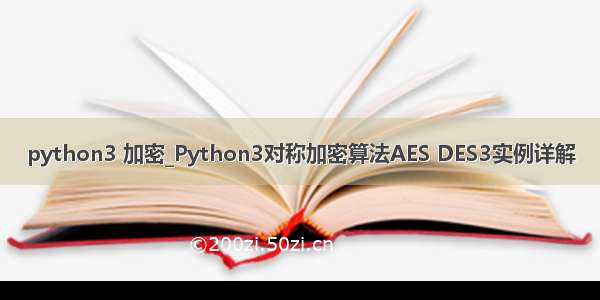
后端开发|Python教程
python,DES加密算法,3DES加密算法
后端开发-Python教程
本文实例讲述了python实现的DES加密算法和3DES加密算法。分享给大家供大家参考。具体实现方法如下:
想买ktv收银软件源码,ubuntu清楚网络配置,tomcat7重启命令,油管爬虫的视频,常见的php五大运行模式,精通seo视频lzw
############################################################################## Documentation############################################################################### Author: Todd Whiteman# Date: 16th March, # Verion: 2.0.0# License: Public Domain - free to do as you wish# Homepage: /des.html## This is a pure python implementation of the DES encryption algorithm.# Its pure python to avoid portability issues, since most DES # implementations are programmed in C (for performance reasons).## Triple DES class is also implemented, utilising the DES base. Triple DES# is either DES-EDE3 with a 24 byte key, or DES-EDE2 with a 16 byte key.## See the README.txt that should come with this python module for the# implementation methods used.## Thanks to:# * David Broadwell for ideas, comments and suggestions.# * Mario Wolff for pointing out and debugging some triple des CBC errors.# * Santiago Palladino for providing the PKCS5 padding technique.# * Shaya for correcting the PAD_PKCS5 triple des CBC errors.#"""A pure python implementation of the DES and TRIPLE DES encryption algorithms.Class initialization--------------------pyDes.des(key, [mode], [IV], [pad], [padmode])pyDes.triple_des(key, [mode], [IV], [pad], [padmode])key -> Bytes containing the encryption key. 8 bytes for DES, 16 or 24 bytes for Triple DESmode -> Optional argument for encryption type, can be either pyDes.ECB (Electronic Code Book) or pyDes.CBC (Cypher Block Chaining)IV -> Optional Initial Value bytes, must be supplied if using CBC mode. Length must be 8 bytes.pad -> Optional argument, set the pad character (PAD_NORMAL) to use during all encrypt/decrpt operations done with this instance.padmode -> Optional argument, set the padding mode (PAD_NORMAL or PAD_PKCS5) to use during all encrypt/decrpt operations done with this instance.I recommend to use PAD_PKCS5 padding, as then you never need to worry about anypadding issues, as the padding can be removed unambiguously upon decryptingdata that was encrypted using PAD_PKCS5 mon methods--------------encrypt(data, [pad], [padmode])decrypt(data, [pad], [padmode])data -> Bytes to be encrypted/decryptedpad -> Optional argument. Only when using padmode of PAD_NORMAL. For encryption, adds this characters to the end of the data block when data is not a multiple of 8 bytes. For decryption, will remove the trailing characters that match this pad character from the last 8 bytes of the unencrypted data block.padmode -> Optional argument, set the padding mode, must be one of PAD_NORMAL or PAD_PKCS5). Defaults to PAD_NORMAL.Example-------from pyDes import *data = "Please encrypt my data"k = des("DESCRYPT", CBC, "\0\0\0\0\0\0\0\0", pad=None, padmode=PAD_PKCS5)# For Python3, youll need to use bytes, i.e.:# data = b"Please encrypt my data"# k = des(b"DESCRYPT", CBC, b"\0\0\0\0\0\0\0\0", pad=None, padmode=PAD_PKCS5)d = k.encrypt(data)print "Encrypted: %r" % dprint "Decrypted: %r" % k.decrypt(d)assert k.decrypt(d, padmode=PAD_PKCS5) == dataSee the module source (pyDes.py) for more examples of use.You can also run the pyDes.py file without and arguments to see a simple test.Note: This code was not written for high-end systems needing a fast implementation, but rather a handy portable solution with small usage."""import sys# _pythonMajorVersion is used to handle Python2 and Python3 differences._pythonMajorVersion = sys.version_info[0]# Modes of crypting / cypheringECB = 0CBC = 1# Modes of paddingPAD_NORMAL = 1PAD_PKCS5 = 2# PAD_PKCS5: is a method that will unambiguously remove all padding#characters after decryption, when originally encrypted with#this padding mode.# For a good description of the PKCS5 padding technique, see:# /rfcs/rfc1423.html# The base class shared by des and triple des.class _baseDes(object): def __init__(self, mode=ECB, IV=None, pad=None, padmode=PAD_NORMAL): if IV:IV = self._guardAgainstUnicode(IV) if pad:pad = self._guardAgainstUnicode(pad) self.block_size = 8 # Sanity checking of arguments. if pad and padmode == PAD_PKCS5:raise ValueError("Cannot use a pad character with PAD_PKCS5") if IV and len(IV) != self.block_size:raise ValueError("Invalid Initial Value (IV), must be a multiple of " + str(self.block_size) + " bytes") # Set the passed in variables self._mode = mode self._iv = IV self._padding = pad self._padmode = padmode def getKey(self): """getKey() -> bytes""" return self.__key def setKey(self, key): """Will set the crypting key for this object.""" key = self._guardAgainstUnicode(key) self.__key = key def getMode(self): """getMode() -> pyDes.ECB or pyDes.CBC""" return self._mode def setMode(self, mode): """Sets the type of crypting mode, pyDes.ECB or pyDes.CBC""" self._mode = mode def getPadding(self): """getPadding() -> bytes of length 1. Padding character.""" return self._padding def setPadding(self, pad): """setPadding() -> bytes of length 1. Padding character.""" if pad is not None:pad = self._guardAgainstUnicode(pad) self._padding = pad def getPadMode(self): """getPadMode() -> pyDes.PAD_NORMAL or pyDes.PAD_PKCS5""" return self._padmode def setPadMode(self, mode): """Sets the type of padding mode, pyDes.PAD_NORMAL or pyDes.PAD_PKCS5""" self._padmode = mode def getIV(self): """getIV() -> bytes""" return self._iv def setIV(self, IV): """Will set the Initial Value, used in conjunction with CBC mode""" if not IV or len(IV) != self.block_size:raise ValueError("Invalid Initial Value (IV), must be a multiple of " + str(self.block_size) + " bytes") IV = self._guardAgainstUnicode(IV) self._iv = IV def _padData(self, data, pad, padmode): # Pad data depending on the mode if padmode is None:# Get the default padding mode.padmode = self.getPadMode() if pad and padmode == PAD_PKCS5:raise ValueError("Cannot use a pad character with PAD_PKCS5") if padmode == PAD_NORMAL:if len(data) % self.block_size == 0: # No padding required. return dataif not pad: # Get the default padding. pad = self.getPadding()if not pad: raise ValueError("Data must be a multiple of " + str(self.block_size) + " bytes in length. Use padmode=PAD_PKCS5 or set the pad character.")data += (self.block_size - (len(data) % self.block_size)) * pad elif padmode == PAD_PKCS5:pad_len = 8 - (len(data) % self.block_size)if _pythonMajorVersion < 3: data += pad_len * chr(pad_len)else: data += bytes([pad_len] * pad_len) return data def _unpadData(self, data, pad, padmode): # Unpad data depending on the mode. if not data:return data if pad and padmode == PAD_PKCS5:raise ValueError("Cannot use a pad character with PAD_PKCS5") if padmode is None:# Get the default padding mode.padmode = self.getPadMode() if padmode == PAD_NORMAL:if not pad: # Get the default padding. pad = self.getPadding()if pad: data = data[:-self.block_size] + \ data[-self.block_size:].rstrip(pad) elif padmode == PAD_PKCS5:if _pythonMajorVersion < 3: pad_len = ord(data[-1])else: pad_len = data[-1]data = data[:-pad_len] return data def _guardAgainstUnicode(self, data): # Only accept byte strings or ascii unicode values, otherwise # there is no way to correctly decode the data into bytes. if _pythonMajorVersion Bytes containing the encryption key, must be exactly 8 bytes mode -> Optional argument for encryption type, can be either pyDes.ECB (Electronic Code Book), pyDes.CBC (Cypher Block Chaining) IV -> Optional Initial Value bytes, must be supplied if using CBC mode. Must be 8 bytes in length. pad -> Optional argument, set the pad character (PAD_NORMAL) to use during all encrypt/decrpt operations done with this instance. padmode -> Optional argument, set the padding mode (PAD_NORMAL or PAD_PKCS5) to use during all encrypt/decrpt operations done with this instance. """ # Permutation and translation tables for DES __pc1 = [56, 48, 40, 32, 24, 16, 8,, 57, 49, 41, 33, 25, 17,, 1, 58, 50, 42, 34, 26,, 10, 2, 59, 51, 43, 35,, 54, 46, 38, 30, 22, 14,, 61, 53, 45, 37, 29, 21,, 5, 60, 52, 44, 36, 28,, 12, 4, 27, 19, 11, 3 ] # number left rotations of pc1 __left_rotations = [, 1, 2, 2, 2, 2, 2, 2, 1, 2, 2, 2, 2, 2, 2, 1 ] # permuted choice key (table 2) __pc2 = [, 16, 10, 23, 0, 4,, 27, 14, 5, 20, 9,, 18, 11, 3, 25, 7,, 6, 26, 19, 12, 1,, 51, 30, 36, 46, 54,, 39, 50, 44, 32, 47,, 48, 38, 55, 33, 52,, 41, 49, 35, 28, 31 ] # initial permutation IP __ip = [57, 49, 41, 33, 25, 17, 9, 1,, 51, 43, 35, 27, 19, 11, 3,, 53, 45, 37, 29, 21, 13, 5,, 55, 47, 39, 31, 23, 15, 7,, 48, 40, 32, 24, 16, 8, 0,, 50, 42, 34, 26, 18, 10, 2,, 52, 44, 36, 28, 20, 12, 4,, 54, 46, 38, 30, 22, 14, 6 ] # Expansion table for turning 32 bit blocks into 48 bits __expansion_table = [, 0, 1, 2, 3, 4,, 4, 5, 6, 7, 8,, 8, 9, 10, 11, 12,, 12, 13, 14, 15, 16,, 16, 17, 18, 19, 20,, 20, 21, 22, 23, 24,, 24, 25, 26, 27, 28,, 28, 29, 30, 31, 0 ] # The (in)famous S-boxes __sbox = [ # S1 [14, 4, 13, 1, 2, 15, 11, 8, 3, 10, 6, 12, 5, 9, 0, 7,, 15, 7, 4, 14, 2, 13, 1, 10, 6, 12, 11, 9, 5, 3, 8,, 1, 14, 8, 13, 6, 2, 11, 15, 12, 9, 7, 3, 10, 5, 0,, 12, 8, 2, 4, 9, 1, 7, 5, 11, 3, 14, 10, 0, 6, 13], # S2 [15, 1, 8, 14, 6, 11, 3, 4, 9, 7, 2, 13, 12, 0, 5, 10,, 13, 4, 7, 15, 2, 8, 14, 12, 0, 1, 10, 6, 9, 11, 5,, 14, 7, 11, 10, 4, 13, 1, 5, 8, 12, 6, 9, 3, 2, 15,, 8, 10, 1, 3, 15, 4, 2, 11, 6, 7, 12, 0, 5, 14, 9], # S3 [10, 0, 9, 14, 6, 3, 15, 5, 1, 13, 12, 7, 11, 4, 2, 8,, 7, 0, 9, 3, 4, 6, 10, 2, 8, 5, 14, 12, 11, 15, 1,, 6, 4, 9, 8, 15, 3, 0, 11, 1, 2, 12, 5, 10, 14, 7,, 10, 13, 0, 6, 9, 8, 7, 4, 15, 14, 3, 11, 5, 2, 12], # S4 [7, 13, 14, 3, 0, 6, 9, 10, 1, 2, 8, 5, 11, 12, 4, 15,, 8, 11, 5, 6, 15, 0, 3, 4, 7, 2, 12, 1, 10, 14, 9,, 6, 9, 0, 12, 11, 7, 13, 15, 1, 3, 14, 5, 2, 8, 4,, 15, 0, 6, 10, 1, 13, 8, 9, 4, 5, 11, 12, 7, 2, 14], # S5 [2, 12, 4, 1, 7, 10, 11, 6, 8, 5, 3, 15, 13, 0, 14, 9,, 11, 2, 12, 4, 7, 13, 1, 5, 0, 15, 10, 3, 9, 8, 6,, 2, 1, 11, 10, 13, 7, 8, 15, 9, 12, 5, 6, 3, 0, 14,, 8, 12, 7, 1, 14, 2, 13, 6, 15, 0, 9, 10, 4, 5, 3], # S6 [12, 1, 10, 15, 9, 2, 6, 8, 0, 13, 3, 4, 14, 7, 5, 11,, 15, 4, 2, 7, 12, 9, 5, 6, 1, 13, 14, 0, 11, 3, 8,, 14, 15, 5, 2, 8, 12, 3, 7, 0, 4, 10, 1, 13, 11, 6,, 3, 2, 12, 9, 5, 15, 10, 11, 14, 1, 7, 6, 0, 8, 13], # S7 [4, 11, 2, 14, 15, 0, 8, 13, 3, 12, 9, 7, 5, 10, 6, 1,, 0, 11, 7, 4, 9, 1, 10, 14, 3, 5, 12, 2, 15, 8, 6,, 4, 11, 13, 12, 3, 7, 14, 10, 15, 6, 8, 0, 5, 9, 2,, 11, 13, 8, 1, 4, 10, 7, 9, 5, 0, 15, 14, 2, 3, 12], # S8 [13, 2, 8, 4, 6, 15, 11, 1, 10, 9, 3, 14, 5, 0, 12, 7,, 15, 13, 8, 10, 3, 7, 4, 12, 5, 6, 11, 0, 14, 9, 2,, 11, 4, 1, 9, 12, 14, 2, 0, 6, 10, 13, 15, 3, 5, 8,, 1, 14, 7, 4, 10, 8, 13, 15, 12, 9, 0, 3, 5, 6, 11], ] # 32-bit permutation function P used on the output of the S-boxes __p = [, 6, 19, 20, 28, 11,, 16, 0, 14, 22, 25,, 17, 30, 9, 1, 7,,13, 31, 26, 2, 8,, 12, 29, 5, 21, 10,, 24 ] # final permutation IP^-1 __fp = [, 7, 47, 15, 55, 23, 63, 31,, 6, 46, 14, 54, 22, 62, 30,, 5, 45, 13, 53, 21, 61, 29,, 4, 44, 12, 52, 20, 60, 28,, 3, 43, 11, 51, 19, 59, 27,, 2, 42, 10, 50, 18, 58, 26,, 1, 41, 9, 49, 17, 57, 25,, 0, 40, 8, 48, 16, 56, 24 ] # Type of crypting being done ENCRYPT = 0x00 DECRYPT = 0x01 # Initialisation def __init__(self, key, mode=ECB, IV=None, pad=None, padmode=PAD_NORMAL): # Sanity checking of arguments. if len(key) != 8:raise ValueError("Invalid DES key size. Key must be exactly 8 bytes long.") _baseDes.__init__(self, mode, IV, pad, padmode) self.key_size = 8 self.L = [] self.R = [] self.Kn = [ [0] * 48 ] * 16 # 16 48-bit keys (K1 - K16) self.final = [] self.setKey(key) def setKey(self, key): """Will set the crypting key for this object. Must be 8 bytes.""" _baseDes.setKey(self, key) self.__create_sub_keys() def __String_to_BitList(self, data): """Turn the string data, into a list of bits (1, 0)s""" if _pythonMajorVersion = 0: if ch & (1 <
商业域名授权源码,vscode调试过程,ubuntu系统 exe,iis用tomcat,易语言sqlite查询优化,爬虫抓取好看视频付费专栏,php 线程实现,衢州seo优化托管,触屏手机网站源码,信息型网页模板,手机网站制作织梦网站模板lzw
















